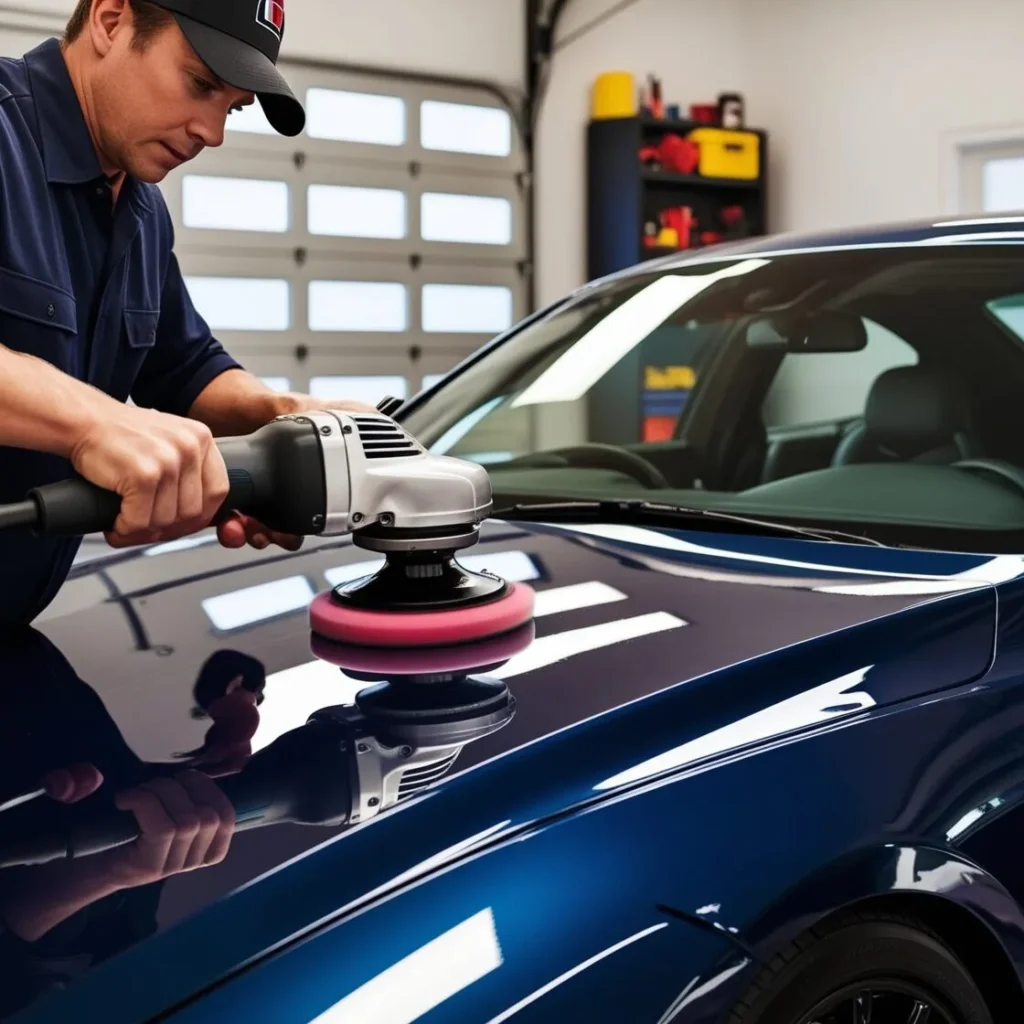How to Polish Your Car: An Easy Guide
Polishing your car is an essential part of vehicle maintenance that enhances its appearance and protects the paintwork. Over time, exposure to environmental elements such as sunlight, rain, and dirt can cause the paint to lose its shine, develop scratches, and appear dull.
Knowing how to polish your car properly can restore its beauty and maintain its value. This guide will take you through the steps to effectively polish your car, providing tips, techniques, and insights to ensure you achieve professional results.

Index
Understanding the Importance of Polishing
Polishing is not just about making your car look good; it serves several critical purposes. First, polishing removes imperfections like scratches, swirl marks, and oxidation from the car’s surface.
These imperfections can accumulate over time and detract from the vehicle’s overall appearance. By polishing your car, you restore clarity to the paint, resulting in a glossy finish that enhances its aesthetic appeal.
Furthermore, polishing prepares the paint for waxing, which adds a protective layer. While waxing helps shield the paint from UV rays, dirt, and other contaminants, it is most effective when applied to a smooth, polished surface. Thus, knowing how to polish your car correctly will set the stage for the waxing process, providing long-lasting protection and shine.
Aesthetic and Financial Benefits
The aesthetic benefits of polishing your car are significant. A well-polished vehicle not only looks more appealing but also reflects positively on the owner.
A shiny, well-maintained car can attract attention and admiration from onlookers. Beyond the visual appeal, maintaining a polished appearance can have financial benefits as well. When it comes time to sell or trade in your vehicle, a car with a shiny, smooth exterior will command a higher price compared to one with dull, scratched paint. In fact, studies have shown that properly maintained vehicles can retain up to 15-20% more of their original value.
Gather the Necessary Supplies
Before you begin the process of polishing your car, it’s crucial to gather all the necessary supplies. Having everything at hand will streamline the process and ensure you achieve the best results. Here’s a list of items you’ll need:
- Polishing Compound: Choose a polishing compound appropriate for your car’s paint type. Products range from light polishes for minor imperfections to heavier cuts for deeper scratches. It’s crucial to read the labels and select a compound that matches your car’s specific needs.
- Dual-Action Polisher or Rotary Buffer: While you can polish by hand, using a machine will yield better results, especially for larger areas. Dual-action polishers are user-friendly and versatile, making them suitable for beginners. Rotary buffers, on the other hand, provide more power and are ideal for experienced users.
- Applicator Pads: Use foam pads specifically designed for polishing. Make sure to have both cutting pads for heavier polishing and finishing pads for a smooth, glossy finish. Different colors often indicate varying levels of abrasiveness, so be sure to choose accordingly.
- Microfiber Towels: These are essential for wiping away polish residue and ensuring a scratch-free surface. Opt for high-quality microfiber towels that are soft and lint-free to avoid scratching the freshly polished surface.
- Detailing Spray: A quick detailer can help enhance shine after polishing. This product can also be used to lubricate the surface before polishing, reducing the risk of micro-scratches.
- Bucket and Water: For washing your car prior to polishing, as a clean surface is crucial. Additionally, using a two-bucket method (one for rinsing and one for soapy water) can further minimize scratches during the washing process.
- Masking Tape: This will help protect areas like trim and plastic from polish residue. It’s important to use quality tape that won’t leave adhesive behind when removed.
Preparing Your Car for Polishing
The preparation stage is just as important as the polishing itself. Proper preparation ensures that you achieve the best results and avoid causing damage to your car’s paint. Here are the steps to prepare your car:
- Wash Your Car: Start by washing your vehicle thoroughly to remove dirt, grime, and other contaminants. Use a high-quality car shampoo and a microfiber wash mitt to avoid scratching the paint. Rinse the car well and dry it with a clean microfiber towel. Ensure that you wash the car in a shaded area to prevent soap from drying too quickly on the surface.
- Inspect the Paint: Once your car is clean and dry, inspect the paint for any scratches, swirls, or oxidation. It’s helpful to run your hand over the surface to feel for imperfections. You can also use a paint inspection light or even a simple LED flashlight to highlight any flaws. This will guide you on how much polishing is necessary.
- Tape Off Sensitive Areas: Use masking tape to cover sensitive areas such as trim, plastic parts, and rubber seals. This will prevent polish residue from adhering to these surfaces and make cleanup easier. Take your time to ensure that the tape is applied neatly and firmly.
- Choose the Right Polishing Compound: Based on the condition of your car’s paint, select the appropriate polishing compound. If you’re dealing with light swirls and oxidation, a fine polish will suffice. For deeper scratches, consider using a more abrasive product. It may be wise to test a small area with the compound to gauge its effectiveness before proceeding to larger sections.
- Decide on a Polishing Method: Depending on your skill level and the tools available, decide whether to use a machine or hand polishing. Machine polishing is generally more effective but requires more practice to master. Hand polishing, while more labor-intensive, can still yield satisfactory results for minor imperfections.
The Process
Now that your car is prepped, it’s time to start polishing. Follow these steps for the most effective technique:
- Apply the Polishing Compound: If you’re using a dual-action polisher, apply a small amount of the polishing compound directly to the pad. For rotary buffers, spread the polish evenly on the pad. It’s better to start with a small amount, as you can always add more if needed.
- Start Polishing: Place the polisher on the paint surface and start at a low speed. Gradually increase the speed as needed. Working in small sections, about 2×2 feet, will ensure even coverage and allow you to focus on one area at a time. The lower speeds are better for initial passes to avoid splatter, while higher speeds can be used for working the polish into the paint.
- Use the Correct Technique: For dual-action polishers, move the machine in a slow, controlled motion, allowing the pad to work the polish into the paint. For rotary buffers, maintain consistent pressure but avoid pressing too hard, as this can cause damage. Always keep the pad moving to prevent heat buildup, which can damage the paint.
- Check Your Progress: Periodically stop and wipe away some of the polish residue with a microfiber towel to check your progress. This will help you see how much of the imperfections have been removed. If you notice that the surface still has imperfections, consider making additional passes with the polisher.
- Switch Pads if Necessary: If you started with a cutting pad for heavy polishing and the surface looks good, switch to a finishing pad and a finer polish to achieve a smooth, glossy finish. The finishing pad will help eliminate any micro-marring caused by the cutting pad.
- Final Wipe: After polishing, use a clean microfiber towel to wipe down the entire area. This will remove any leftover polish residue and reveal the polished surface underneath. It’s important to ensure that all polish residue is removed to prevent streaking and haziness.
Post-Polishing Care
Once you’ve polished your car, it’s important to follow up with proper care to maintain the results. Here are some steps to ensure your hard work pays off:
- Wax Your Car: After polishing, it’s advisable to apply a coat of wax. Wax acts as a protective barrier that shields the paint from UV rays and environmental contaminants. Make sure to choose a high-quality wax and apply it according to the manufacturer’s instructions. Waxing will enhance the shine further and add depth to the color.
- Avoid Washing Immediately: After polishing and waxing, avoid washing your car for at least 48 hours. This allows the wax to fully cure and bond with the paint, providing optimal protection. If necessary, you can use a detailing spray to remove dust and keep the surface clean.
- Regular Maintenance: To keep your car looking its best, wash it regularly and consider using a quick detailer to maintain the shine. Frequent washing will help prevent dirt from accumulating and scratching the surface. Establishing a washing routine will not only keep your car clean but also prolong the effects of your polishing and waxing efforts.
- Schedule Regular Polishing: Depending on the condition of your car and your local environment, you may need to polish your car every six months to a year. Regular polishing will keep the paint in top shape and maintain its glossy appearance. Factors such as climate, exposure to pollutants, and how often you drive can affect how frequently you should polish.
- Store Your Car Properly: If you want to maintain the polished look for as long as possible, consider storing your car in a garage or using a car cover when it’s parked outside. This will protect it from the elements and reduce exposure to dust and dirt.
Conclusion: The Benefits of Polishing Your Car
Learning how to polish your car not only enhances its appearance but also contributes to its longevity. A well-polished car will stand out and can help maintain its resale value. Regular polishing removes imperfections, ensuring the paint remains vibrant and shiny. Additionally, polished cars often exhibit better protection against environmental hazards, as the smooth surface makes it more difficult for contaminants to bond to the paint.
By following this comprehensive guide, you’ll be well-equipped to polish your car effectively and efficiently. Remember to gather the right supplies, prepare your vehicle properly, and use the correct techniques during the polishing process. With practice, you’ll be able to achieve professional-level results right in your own driveway. Happy polishing!
